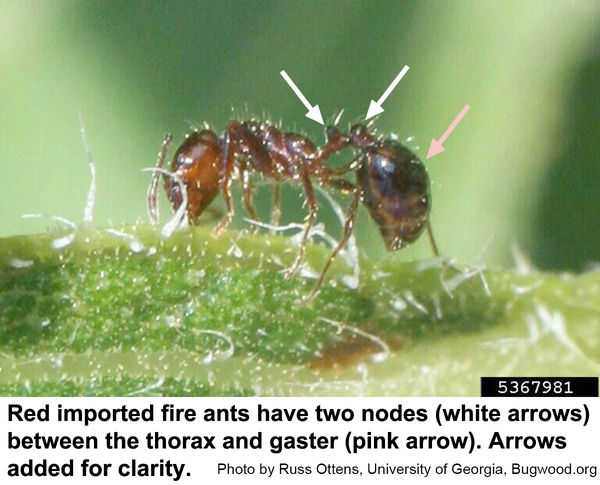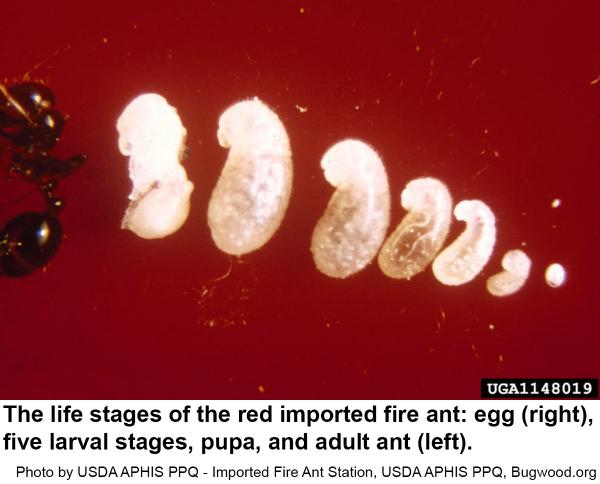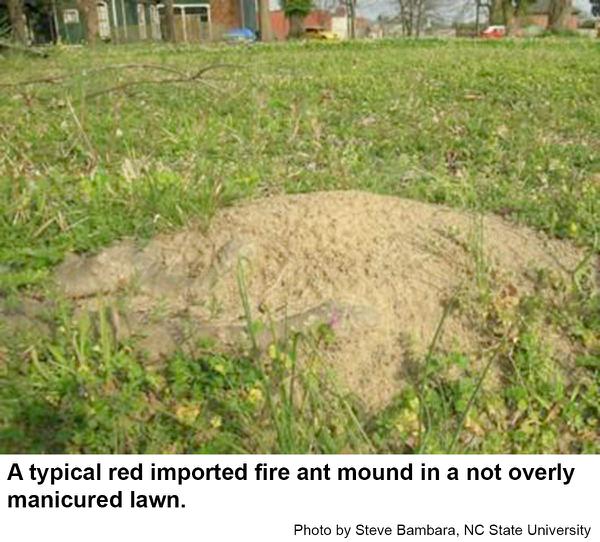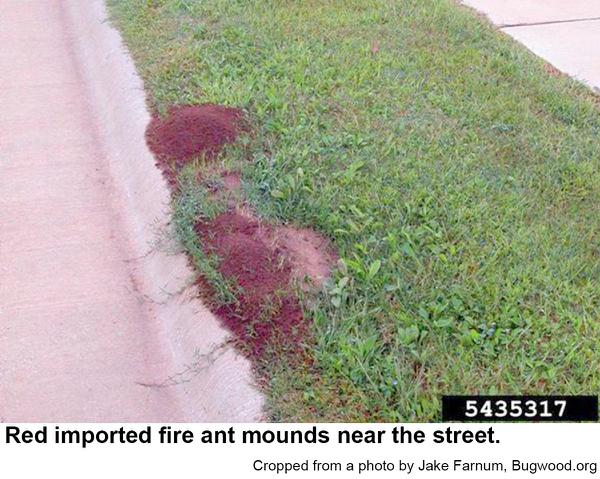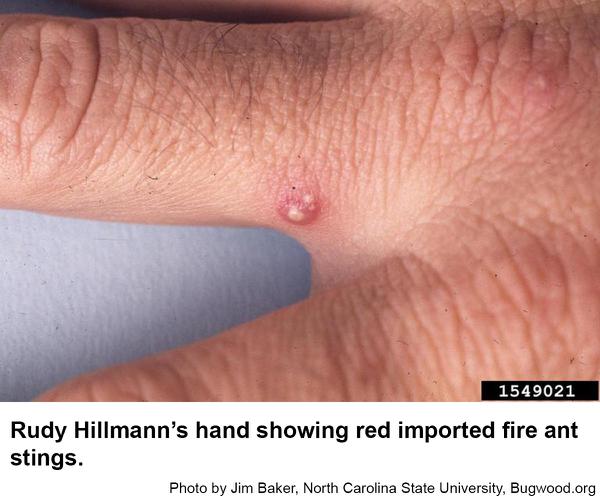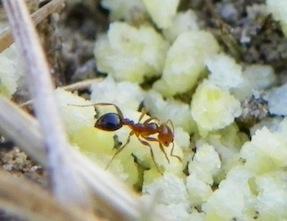Introduction
Red imported fire ants, Solenopsis invicta, were accidentally imported into Mobile, AL about 1930. Since then, they have spread rapidly into most of the southeastern states and a few western states primarily through commerce. They are now in most of North Carolina except some of the northern tier counties. You should accept that you will never get rid of them, but you can manage them. This note should help a homeowner take control of the home lawn. Professional lawn care businesses are also an option and they have a few additional products available that are not sold in big box stores and garden centers.
Fire ants produce mounds that may continue to enlarge as the population grows. Young colonies may not have mounds. Mounds are usually located in sunny areas and often next to sidewalks, driveways or other heat absorbing masses.
Description and Biology
The red imported fire ant is our most troublesome ant in North Carolina landscapes. They are typical reddish brown ants with darker nodes and gaster. Fire ants have two nodes (humps) whereas almost all other ants have only one node. Fire ant colonies are have three forms: fertile females (queens) that lay all of the eggs, winged males, and infertile workers. Workers develop into three sizes: minim (about 1/8 inch), minor or media, and major workers (about ¼ inch). The queen lays and tends the initial egg cluster. After the initial brood has developed into workers, she continues to lay eggs as the workers take over care of all other functions of the colony including rearing their new siblings and defending the nest. A typical mature colony contains 100,000 to 500,000 workers with relatively few winged (reproductive) forms. Eventually the winged forms swarm out of the nest and participate in an aerial mating swarm. The males die shortly thereafter. Newly fertilized queens land, break off their wings, and excavate a cell in which eggs are laid to start a new colony. Some colonies have multiple queens. Such colonies may bud off new colonies nearby. These ants build mounds in any type of soil, but seem to prefer open, sunny areas such as lawns and pastures. The above ground part of the mound is only a small portion of the nest, which may be three feet deep. In urban areas, fire ants invade lawns, parks, play grounds, school yards, cemeteries and golf courses. A noticeable mound from which ants boil out aggressively when disturbed is most likely that of the red imported fire ant.
Management
The best seasons to treat fire ants are late spring and late September to early October before soil temperatures cool. However, an active mound in an inconvenient location, can be drenched on any warm day. The most effective management program combines a two-step process combining direct mound treatment and baits. If there are too many mounds, baiting may be the best solution, but patience is required. It is better to use a bait first and follow up with mound treatment a few days later if the bait seems too slow. Test for activity with a potato chip. Drop the chip lightly on the mound. Workers should emerge within a few minutes. DO NOT use both mound drench and bait at the same time. That wastes bait. If there is still activity 5 to 7 days later or a satellite mound has sprung up, then follow with bait. Some products are made for application across the entire lawn. An effective management program also requires monitoring several times per year. Remember, fire ants can re-invade whenever the wind blows a queen into the yard.
Bait Treatment
Read the label. Baiting may be done near specific mounds, or broadcast across a large area. Baits generally, should not be applied directly onto the mound. Ants do not forage on top of the mound. Fire ant entrances are located around the outside edges of a mound. Not all baits that can be used at a mound may also be used as a broadcast. Baits are actually food and depend upon that food being attractive for the ants to take it in. Some baits are direct poisons and some are insect growth regulators, which cause the colony to die out more gradually. Baits are slower acting than direct mound poisons so do not expect results overnight. Baits rely on foragers to collect the food and bring it back to the rest of the colony to eat. In mid-morning before baiting, drop one or two potato chips near a mound. If ants are consuming the potato chips at 20 minutes, it is a good time to apply bait.
Tips for success:
- Buy fresh bait and store for only a short time.
- Do not store bait near other pesticides, fuels or products from which it will absorb odors.
- Do not apply it to wet grass or when rain is expected within 24 hours.
- Do not disturb the mound. Ants that are rebuilding or defending a nest are not busy foraging.
| Bait Product Name | Active Ingredient | Formulation |
|---|---|---|
| Amdro Fire Ant Bait | hydramethylnon | bait |
| Amdro FireStrike baits | hydramethylnon + methoprene | baits |
| Come 'n Get It Fire Ant Killer by Fertilome | spinosad | bait |
| GreenLight Fire Ant Control with Conserve | spinosad | bait |
| Ortho ecosense brand | spinosad | bait |
| Over 'n Out Mound Treatment | indoxacarb | bait |
| Spectracide Fire Ant Once and Done | indoxacarb | bait |
Direct Contact Treatment (nonbait insecticides)
Directly treating a mound is the fastest method for killing a specific mound. Even so, it is hard to kill every ant and more importantly the queen(s), with certainty. Mounds can be treated directly with insecticide. The insecticide could be powder or granules that are applied atop the mound and then watered into the soil, or they may be dry or liquid insecticides that are mixed with water and then drenched onto the mound. Read the directions carefully for the product you are using. If it is too cold or too hot, ants may not be near the top of the mound. Mid-morning is a good time when temperatures are not too hot nor too cool and mound ants are near the surface. Somewhere near 70°F would be good.
Tips for success:
- Use adequate volume of water. (1.5 to 2.0 gallon per mound)
- Treat mound in mid morning while ants are closest to the surface.
- Normally, do not disturb the nest. Ants will move the queen immediately away from any disturbance and she is less likely to come in contact with treatment.
- Follow up a few days later to see if there are any nearby satellite mounds that sprung from the parent mound.
| Mound Treatment Product Name | Active Ingredient | Formulation |
|---|---|---|
| Amdro Quick Kill Fire Ant Mound Drench | z-cypermetrin | hose end spray |
| Basic Solutions Fire Ant Killer by Ortho | deltamethrin | granules |
| Bayer Advanced Powerforce Multi-Insect Killer | cyflutrin | granules |
| Bonide Stinger Fire Ant Killer | bifenthrin | granules |
| Eliminator Fire Ant Killer Plus! | permethrin | granules |
| Hi-Yield Imported Fire Ant Control Granules | deltamethrin | granules |
| Ortho Fire Ant Killer Mound Treatment | bufenthrin | granules |
| Ortho Max Fire Ant Killer Broadcast Granules | bifenthrin | granules |
| Over 'n Out Fire Ant Killer Granules (broadcast) | bifenthrin | granules |
| Orange Guard | d-limonene | liquid concentrate |
| Spectracide Fire Ant Killer Granules Mount Destroyer | L-cyhalothrin | granules |
FAQs
- Can I use the lawn products in my vegetable garden, too? Not necessarily. Check the label.
- How long can a bait be stored? This may range from 1-3 months. Do not buy any more product than you can use quickly. Check the label.
- Are these products safe around pets? When used as directed, pyrethroids are very toxic to insects but are not particularly hazardous to humans and pets (other than fish—avoid using pyrethroids around pools, ponds, and streams). Baits contain such a tiny amount of active ingredient that they are considered safe. Insect growth regulator baits are even safer. To reduce exposure, exclude pets from treated areas for 12-24 hours after bait application.
Other Resources
- 2017 Fire Ant Control Materials for Alabama Homeowners. Flanders, K. 2017. Extension Alabama A&M &Auburn University
- Common name: red imported fire ant, scientific name: Solenopsis invicta Buren (Insecta: Hymenoptera: Formicidae: Myrmicinae). Collins, L. and R. H. Scheffrahn. 2016 (revised). Featured Creatures, Entomology & Nematology, FDACS/DPI, EDIS. Publication Number: EENY-195
- Red imported Fire Ant in North Carolina. Waldvogel, M. and P. Alder. 2019. Biting and Stinging Pests, NC State Extension Publications.
- NC State Extension Plant Pathology Publications
- NC State Horticultural Science Publications
- North Carolina Agricultural Chemicals Manual
For assistance with a specific problem, contact your local Cooperative Extension center.
This Insect Note has not been peer reviewed.
Publication date: Sept. 1, 2009
Reviewed/Revised: Dec. 14, 2022
Recommendations for the use of agricultural chemicals are included in this publication as a convenience to the reader. The use of brand names and any mention or listing of commercial products or services in this publication does not imply endorsement by NC State University or N.C. A&T State University nor discrimination against similar products or services not mentioned. Individuals who use agricultural chemicals are responsible for ensuring that the intended use complies with current regulations and conforms to the product label. Be sure to obtain current information about usage regulations and examine a current product label before applying any chemical. For assistance, contact your local N.C. Cooperative Extension county center.
N.C. Cooperative Extension prohibits discrimination and harassment regardless of age, color, disability, family and marital status, gender identity, national origin, political beliefs, race, religion, sex (including pregnancy), sexual orientation and veteran status.

